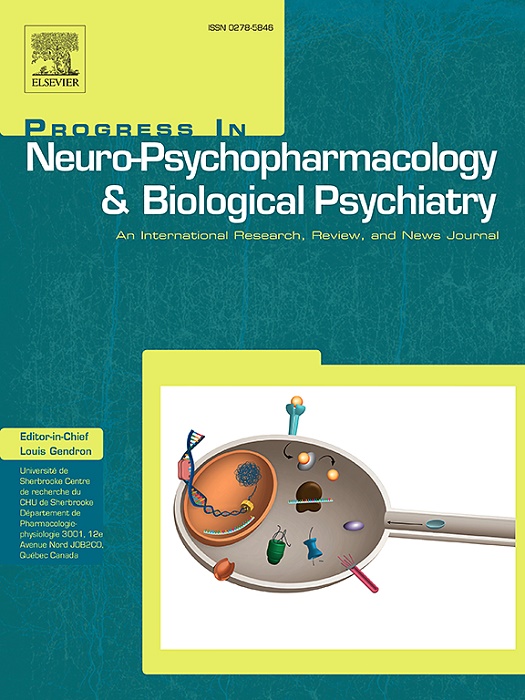Enhancing addiction care: Benefits of urinary screening with LC-HRMS (liquid chromatography-high resolution mass spectrometry) for psychoactive substances and drugs
IF 3.9
2区 医学
Q1 CLINICAL NEUROLOGY
Progress in Neuro-Psychopharmacology & Biological Psychiatry
Pub Date : 2025-08-10
DOI:10.1016/j.pnpbp.2025.111465
引用次数: 0
Abstract
Introduction
Immunoassay (IA) is currently used at Nantes University Hospital to perform urine drug screening in the inpatient addiction unit. Given its numerous limitations, we aimed to assess the overall benefit of the Liquid-Chromatography-High-Resolution-Mass Spectrometry (LC-HRMS), and to identify the profiles of patients for whom its use provided a clinical benefit.
Methods
All adult patients admitted to this unit between January and September 2023 were systematically included. A part of the urine sample routinely collected on admission was retained for subsequent analysis by LC-HRMS. For each active molecule, the analytical performance of LC-HRMS compared with IA was evaluated by biologists. Then unit's physicians assessed for each patient whether the new data provided by LC-HRMS would have had an impact on their management. A multivariate analysis was carried out to identify the profiles of these patients.
Results
154 patients were included with 293 non-prescribed molecules and 434 prescribed drugs. For 2/3 of all molecules, LC-HRMS performed better than IA. Most of these molecules were not detectable by IA but some were not detected even though they belonged to the panel of detectable substances. Physicians considered that the new results provided by LC-HRMS would have had an impact on the management of 1/4 of patients. A history of opiate abuse/dependence was associated with a clinical benefit of LC-HRMS in the multivariate analysis.
Conclusion
These results confirm the benefit of LC-HRMS for urine drug screening in inpatient addiction units for patients with multiple substance use, especially those with a history of opioid use.
加强成瘾护理:使用LC-HRMS(液相色谱-高分辨率质谱)对精神活性物质和药物进行尿液筛查的益处
介绍免疫测定法(IA)目前在南特大学医院的住院成瘾科进行尿液药物筛查。鉴于其诸多局限性,我们旨在评估液相色谱-高分辨率质谱(LC-HRMS)的总体效益,并确定其使用可提供临床益处的患者概况。方法系统收集2013年1 - 9月在该科收治的所有成年患者。入院时常规收集的部分尿样留待LC-HRMS分析。对于每个活性分子,生物学家对LC-HRMS与IA的分析性能进行了比较。然后,该单位的医生为每位患者评估LC-HRMS提供的新数据是否会对他们的管理产生影响。进行多变量分析以确定这些患者的概况。结果共纳入154例患者,非处方分子293种,处方药物434种。对于2/3的分子,LC-HRMS的表现优于IA。这些分子大多是IA检测不到的,但有些分子即使属于可检测物质,也没有被检测到。医生认为LC-HRMS提供的新结果将对1/4患者的管理产生影响。在多变量分析中,阿片类药物滥用/依赖史与LC-HRMS的临床获益相关。结论LC-HRMS可用于多种药物使用患者,特别是有阿片类药物使用史的住院成瘾患者尿液药物筛查。
本文章由计算机程序翻译,如有差异,请以英文原文为准。
求助全文
约1分钟内获得全文
求助全文
来源期刊
CiteScore
12.00
自引率
1.80%
发文量
153
审稿时长
56 days
期刊介绍:
Progress in Neuro-Psychopharmacology & Biological Psychiatry is an international and multidisciplinary journal which aims to ensure the rapid publication of authoritative reviews and research papers dealing with experimental and clinical aspects of neuro-psychopharmacology and biological psychiatry. Issues of the journal are regularly devoted wholly in or in part to a topical subject.
Progress in Neuro-Psychopharmacology & Biological Psychiatry does not publish work on the actions of biological extracts unless the pharmacological active molecular substrate and/or specific receptor binding properties of the extract compounds are elucidated.

 求助内容:
求助内容: 应助结果提醒方式:
应助结果提醒方式:


